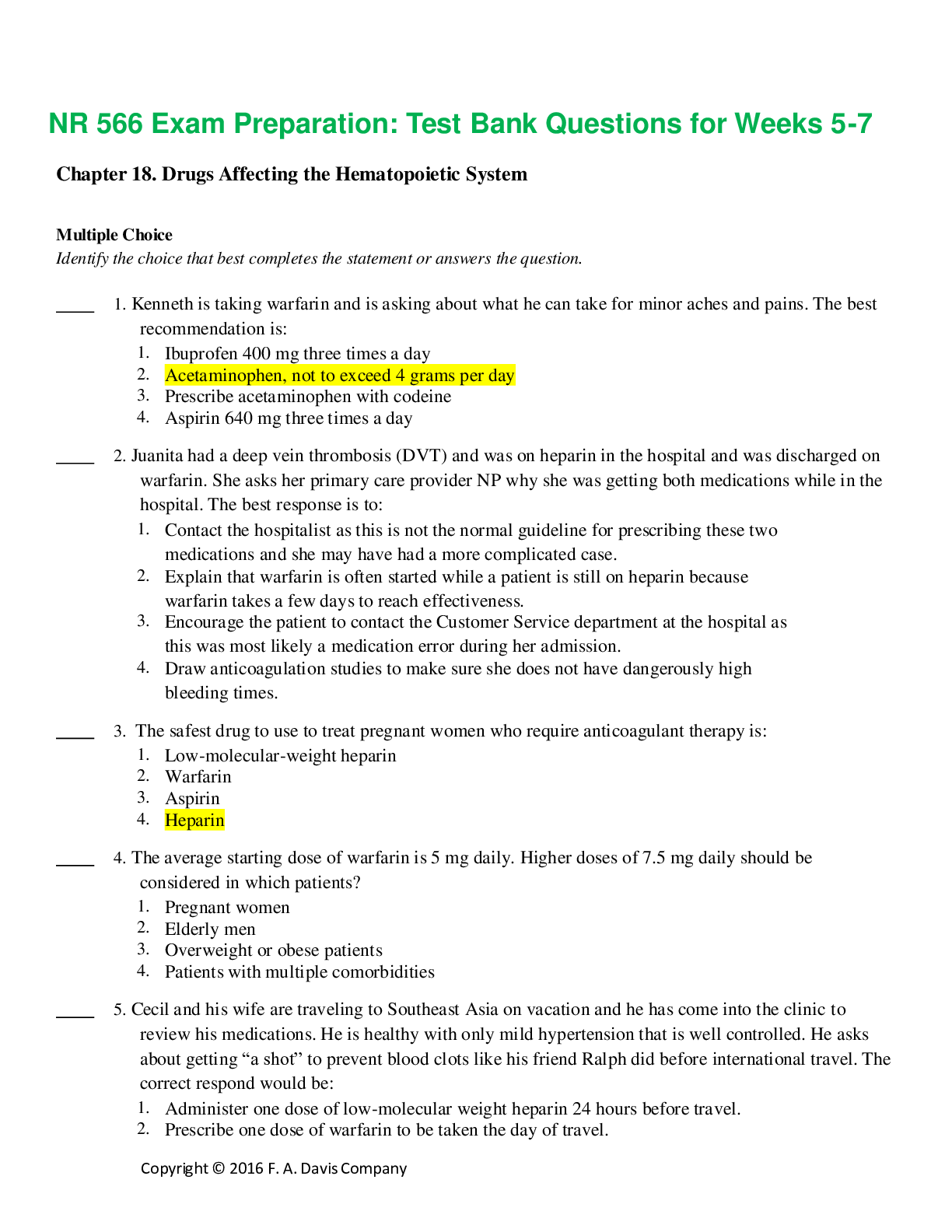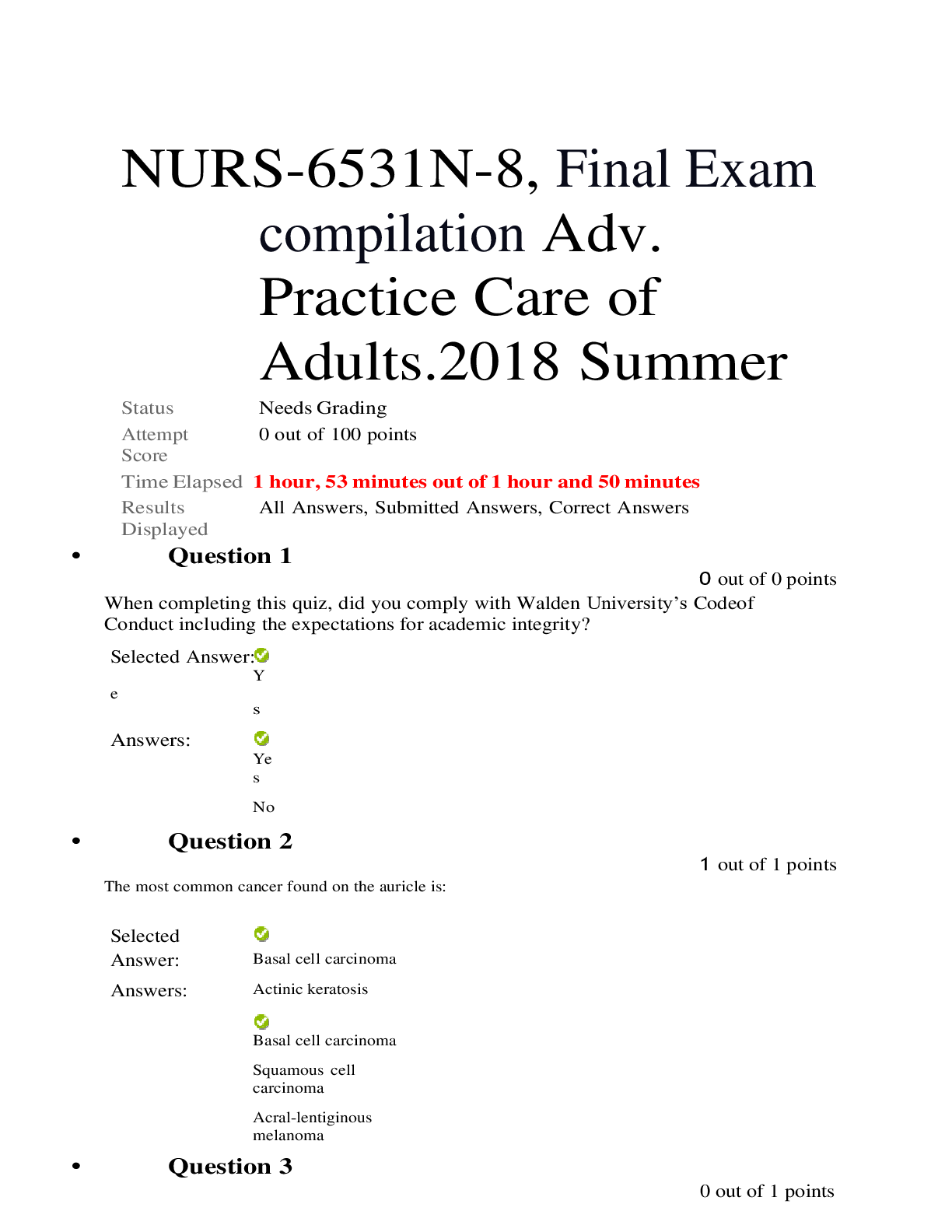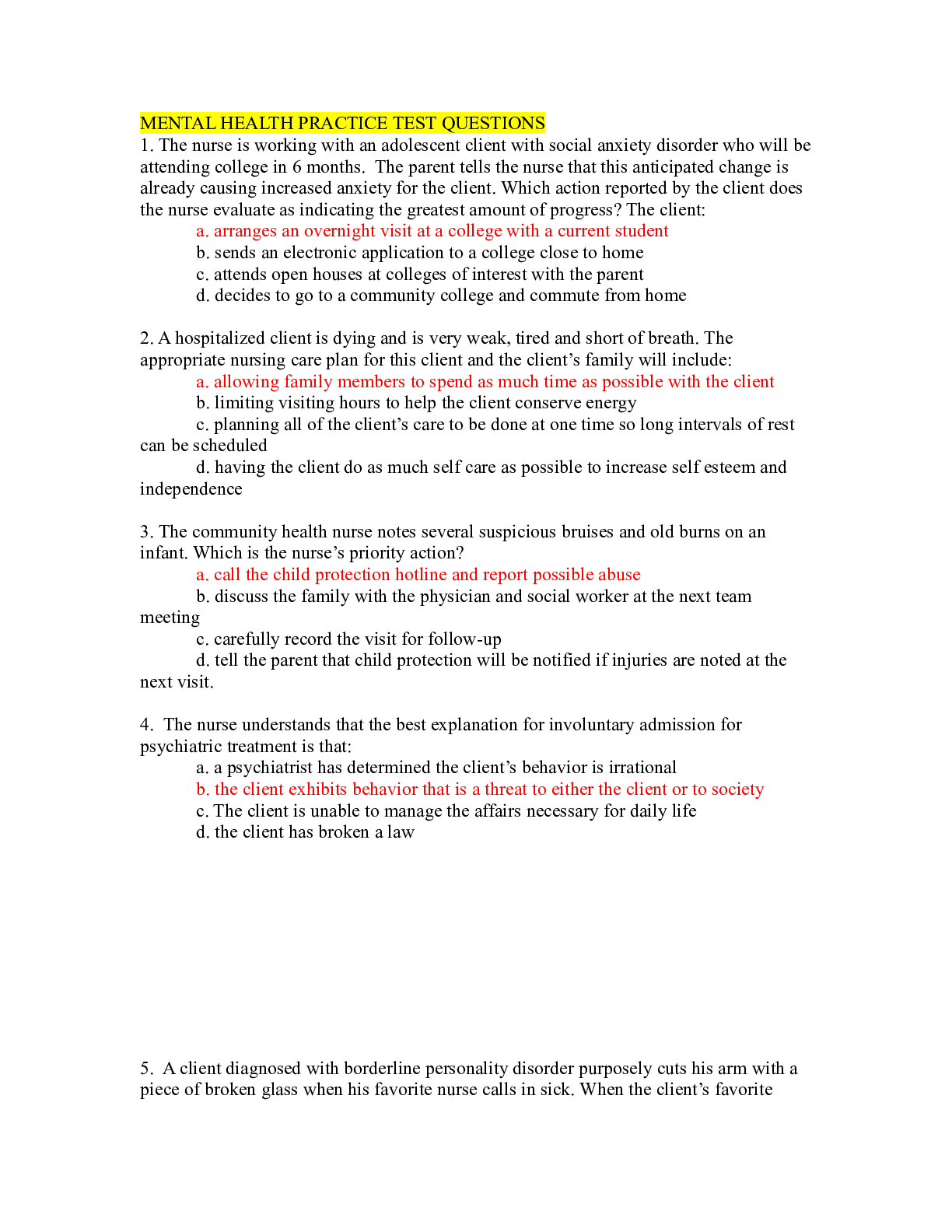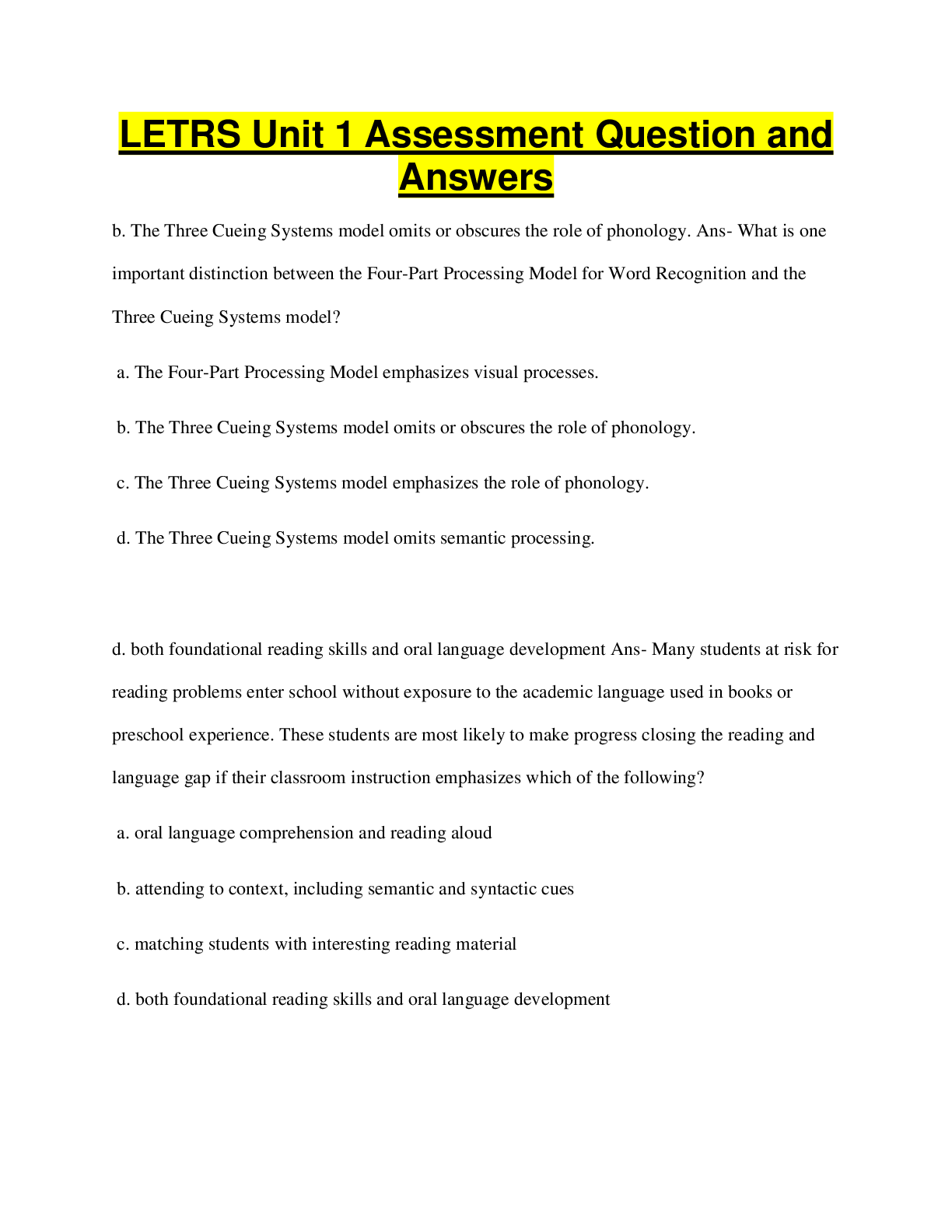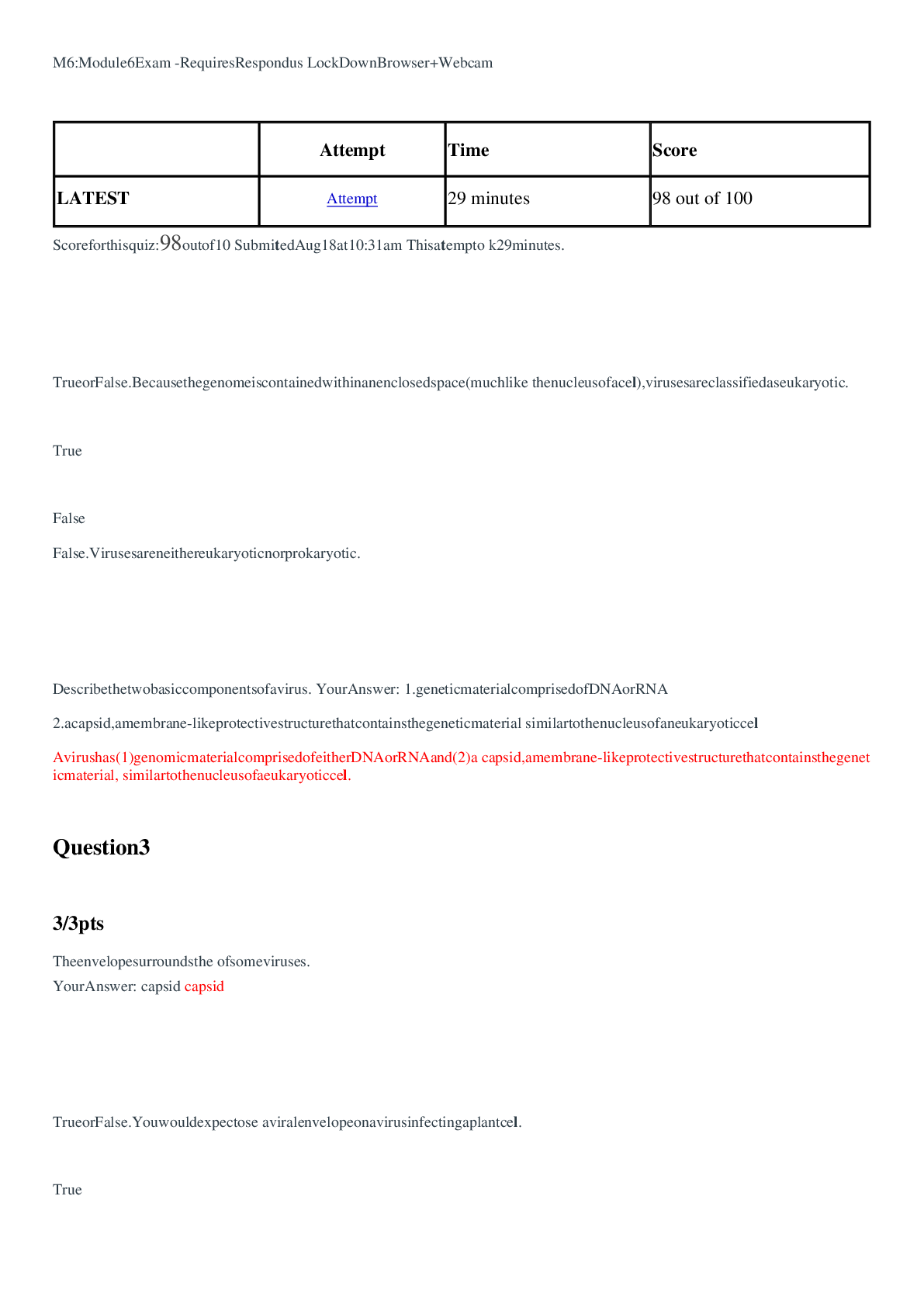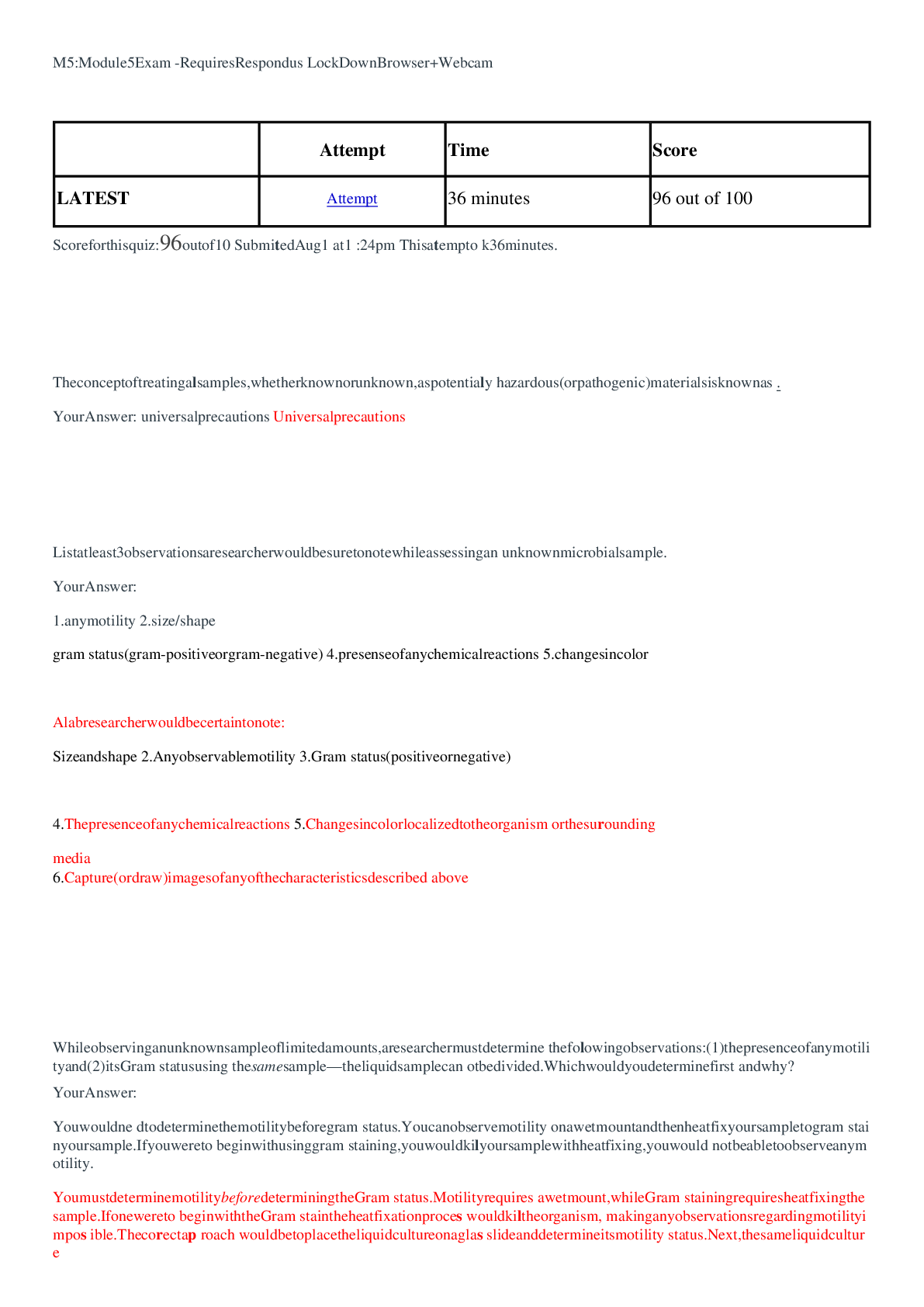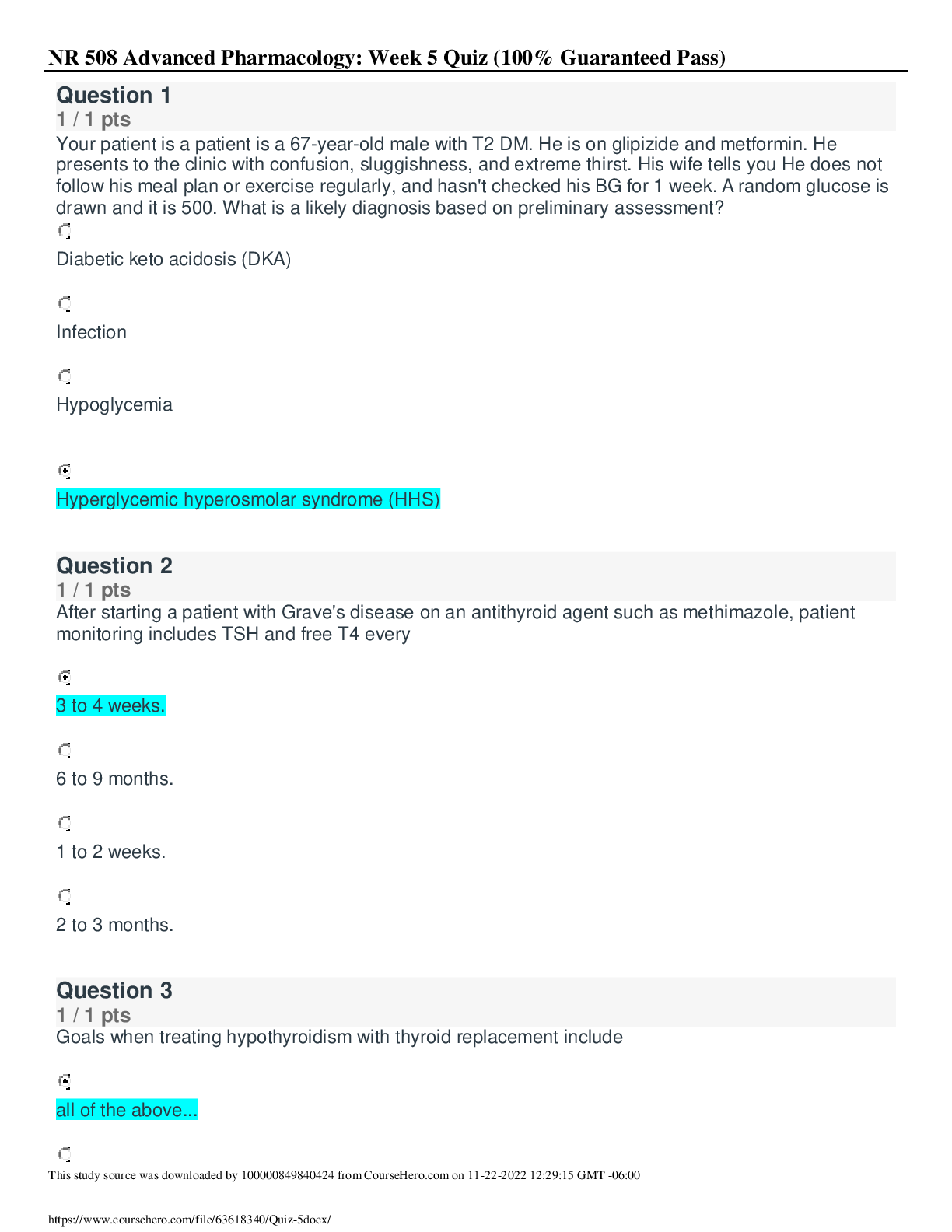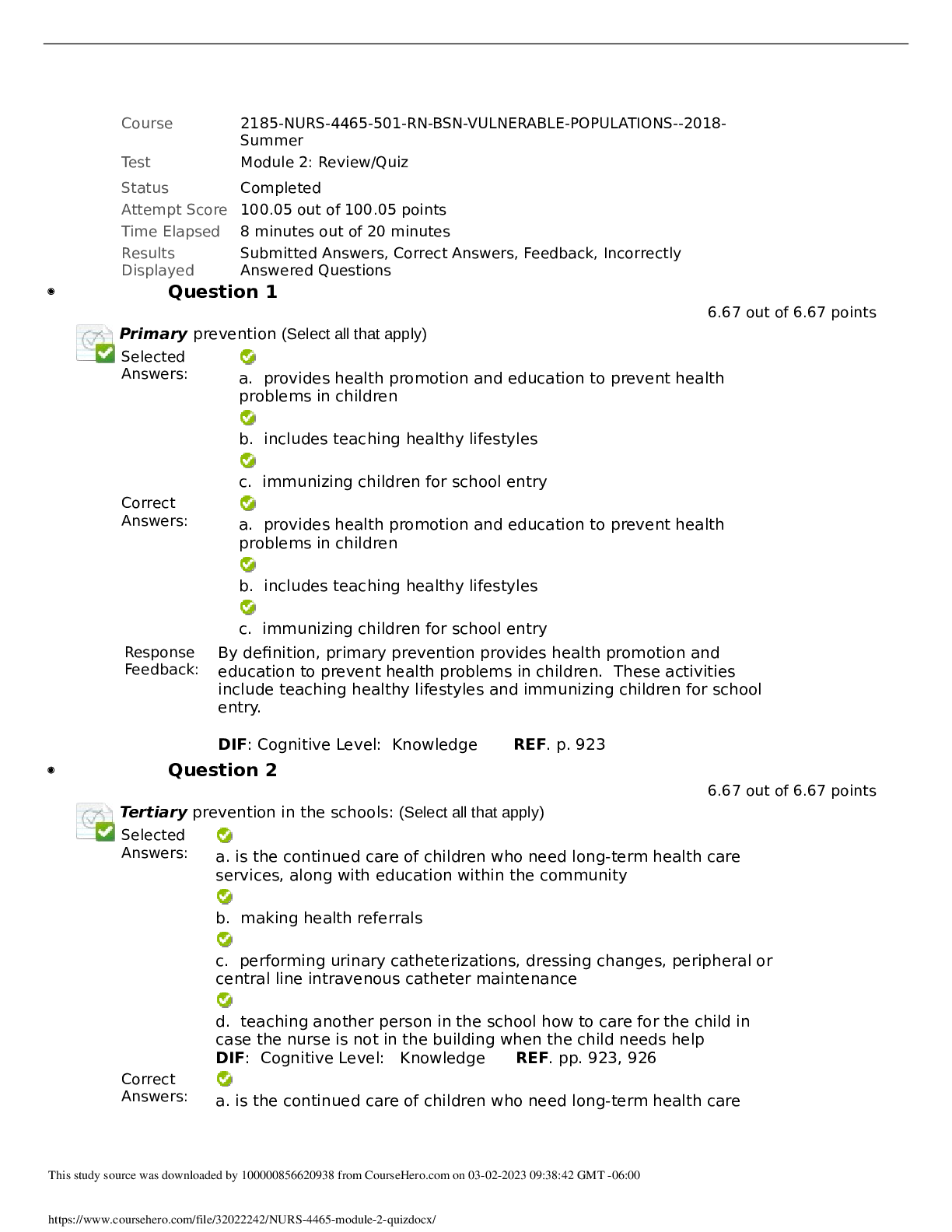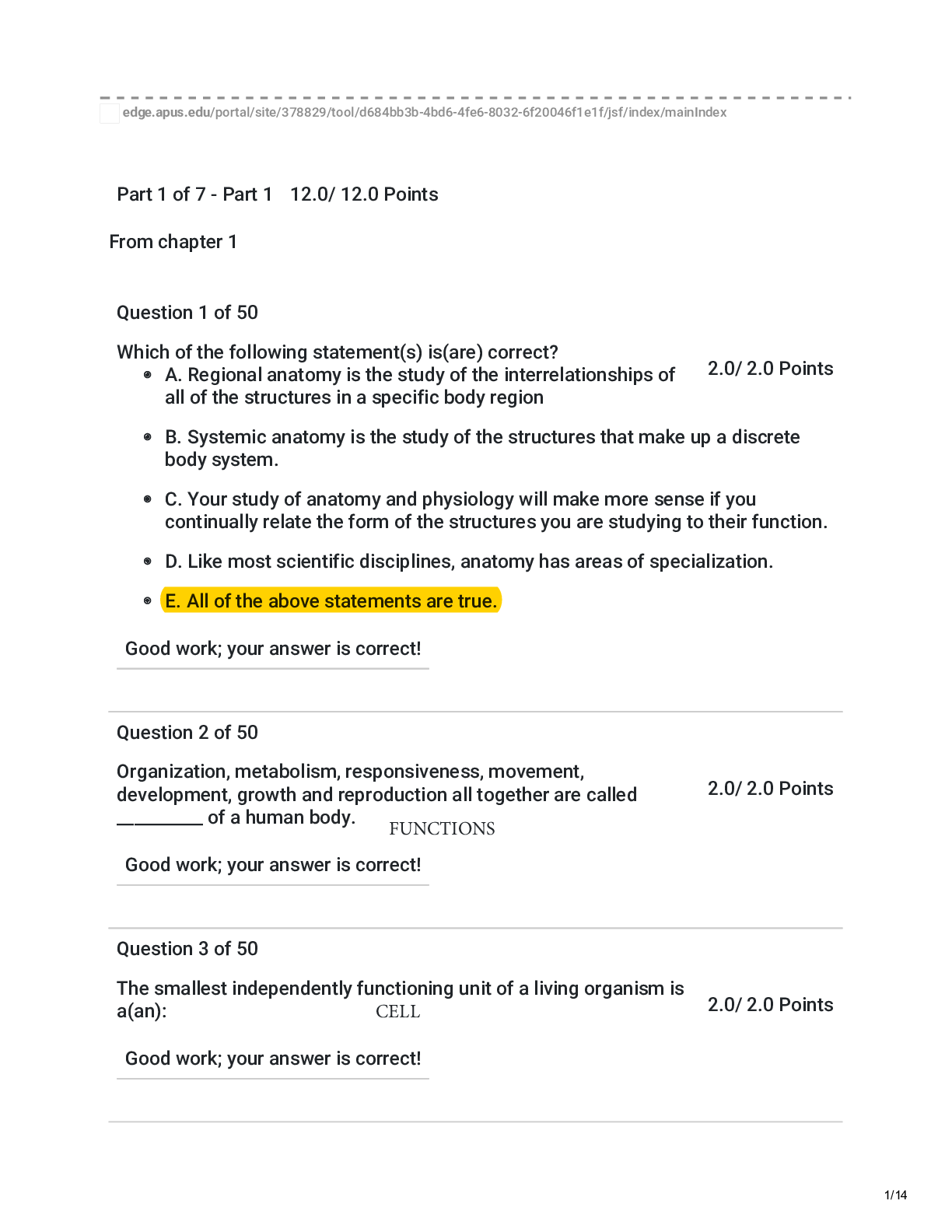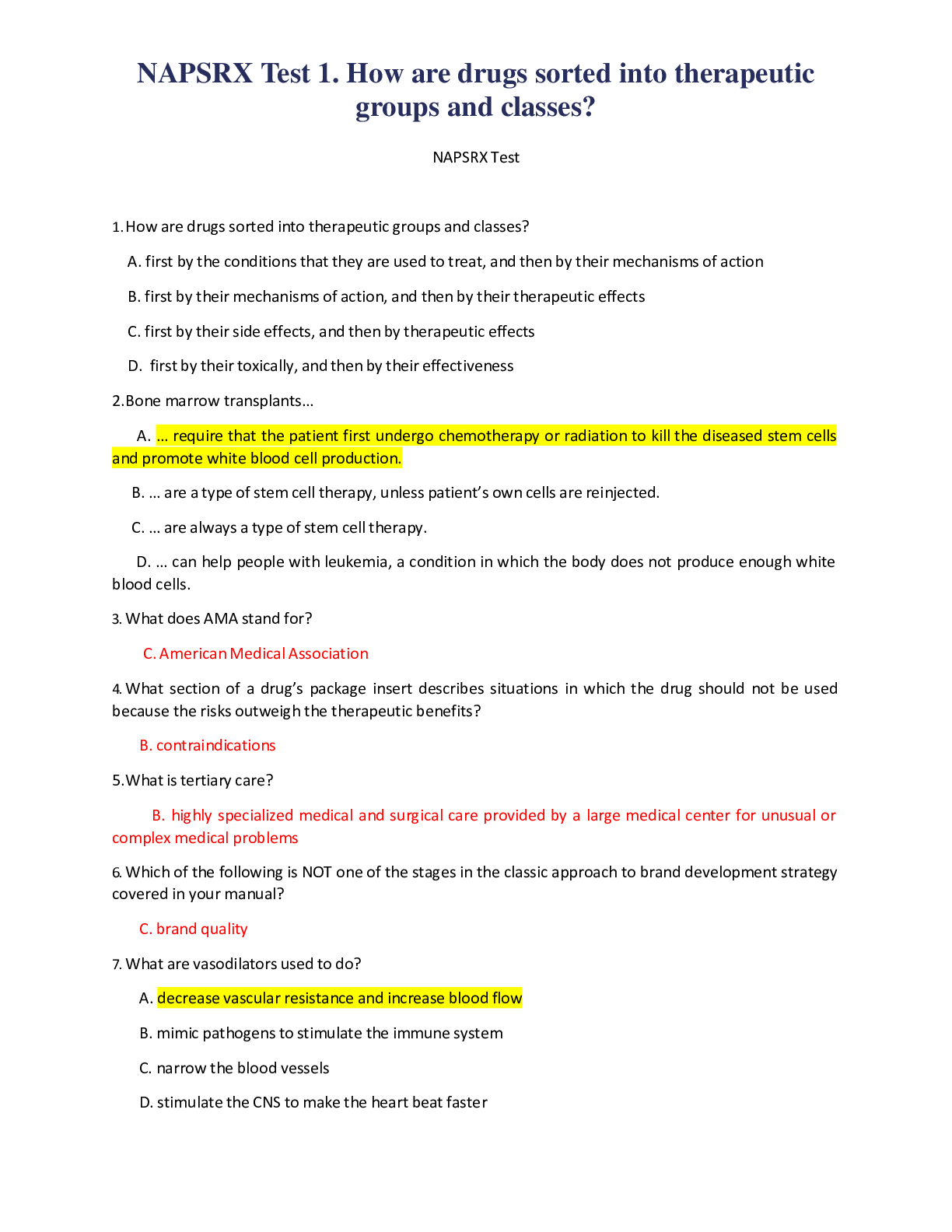*NURSING > EXAM > RN Concept-Based Assessment Level 1, 2 and 3 (RATED A+) Questions and Answer elaborations | 100% Ver (All)
RN Concept-Based Assessment Level 1, 2 and 3 (RATED A+) Questions and Answer elaborations | 100% Verified
Document Content and Description Below
RN Concept-Based Assessment Level 1, 2 and 3 1. A nurse is admitting a client who has pulmonary tuberculosis. Which of the following transmission-based precautions should the nurse initiate? ... • Airborne • Rationale: Pulmonary tuberculosis is an infection that is transmitted by airborne droplets smaller than 5 microns in diameter. Therefore, this client requires airborne precautions to prevent communicating this infection to others 2. A nurse in a mental health facility is preparing an educational program for a group of staff nurses about the proper use of restraints. Which of the following information should the nurse plan to include? • An adult client may be in a mechanical restraint for up to 4 hours • Rational: The nurse should specify that a client who is 18 years or older may be in a restraint for no more than 4 hr. Children who are 9 to 17 years old are limited to 2 hr and children who are younger than 9 years old are limited to 1 hr 3. A nurse is teaching sleep hygiene to a client who has insomnia. Which of the following statements should the nurse make? • Exercise in the morning after arising • Rationale: Daily exercise has many benefits, including enhancing cardiovascular, psychological, and musculoskeletal health. The nurse should recommend that the client avoid exercising within 2 hr of bedtime to limit stimulation and enhance sleep 4. A nurse is preparing to leave the room of a client who is on isolation precautions. Which of the following actions should the nurse take when removing a tied surgical mask? • Remove the mask by securely holding the ties and moving it away from the face • Rationale: The nurse should untie the bottom strings and then the top strings. Finally, while still holding the strings, the nurse should remove the mask from her face. This action prevents the nurse from touching the front of the mask, which is contaminated 5. A nurse is caring for an adolescent client who is in critical condition following a motor vehicle crash in which he was the passenger. The client's parent shouts at the nurse, asking why her son is dying instead of the driver. Which of the following actions should the nurse take to provide emotional support to the parent? • Inform the parent that anger is a natural response when dealing with loss • Rationale: The nurse should identify that the parent is in the anger stage of grief. The nurse should assist the parent to understand that anger is a natural response to loss and encourage her to talk about her feelings 6. A community health nurse is planning prevention strategies for hypertension among members of her community. The nurse should identify that which of the following ethnic groups in the community is at greatest risk of developing hypertension? • African Americans • Rationale: Evidence-based practice indicates that individuals of African- American ethnicity have the highest prevalence of hypertension. Therefore, the nurse should identify community members of this ethnicity are at greatest risk of developing hypertension. 7. A community health nurse is planning interventions to promote Healthy People 2020 initiatives in the community. Which of the following actions should the nurse plan to take first? • Determine the level of health equity among groups in the community • Rationale: Health equity among all groups in the community is a Healthy People 2020 initiative. Using the nursing process, the first action the nurse should take is to assess the needs of the community. By identifying disparities in community health, the nurse can develop interventions targeted at the community's specific needs. 8. A nurse is reviewing a client's new prescriptions that were just documented in the client's medical record by the provider. Which of the following abbreviations should the nurse clarify with the provider? • Enoxaparin 40 mg SQ QD • Rationale: The nurse should clarify this prescription with the provider. The abbreviations "SQ" and "QD" are considered error-prone and should not be used in documentation. The nurse should clarify that the provider intends the prescription to be administered subcutaneously once daily. "Subcutaneous" or "subcut" should be used instead of "SQ" and "daily" should be used instead of "QD." 9. A nurse is talking with a client who has major depressive disorder. The client states, "Nobody cares if I'm around or not." Which of the following responses should the nurse take? • It sounds as though you’re feeling hopeless • Rationale: This statement by the nurse is an example of restating, which is a therapeutic response. This technique restates the main idea the client has expressed and allows the client to clarify any misunderstanding. 10. A nurse is preparing to administer a unit of packed RBCs to a client. In adherence with the Joint Commission National Patient Safety Goals regarding blood administration, which of the following actions should the nurse plan to take? • Verify the client and blood component using a two-person process • Rationale: The Joint Commission National Patient Safety Goals regarding blood transfusions includes improving the accuracy of client identification. The nurse should eliminate transfusion errors related to client misidentification by using a two-person verification process to identify the client and the blood component. 11. A nurse on a medical-surgical unit is caring for a group of clients. Which of the following clients should the nurse monitor for the development of reflex urinary incontinence? • A client who has a T12 spinal cord injury • Rationale: The nurse should identify that a client who has a C1 to S2 spinal cord injury is at risk of developing reflex urinary incontinence. With this type of incontinence, the client is unaware that the bladder is full and therefore lacks the urge to void, resulting in the involuntary loss of urine. The nurse should monitor for this form of incontinence and implement interventions such as intermittent catheterization. 12. A nurse is documenting an assessment in a client's electronic health record when an assistive personnel (AP) asks to enter the morning blood glucose for the client. Which of the following actions should the nurse take? • Request that the AP use another computer to enter the data • Rationale: The nurse should request that the AP to go to another computer that is not in use to enter the morning blood glucose from the client. This is time-sensitive data that needs to be entered in the computer as soon as possible. 13. A nurse is preparing to administer acetaminophen 120 mg PO to a toddler. Available is acetaminophen drops 80mg/0.8 mL. How many mL should the nurse administer? (Round the answer to the nearest tenth. Use a leading zero if it applies. Do not use a trailing zero.) • 1.2 mL • Rationale: Ratio and Proportion • STEP 1: What is the unit of measurement the nurse should calculate? mL • STEP 2: What is the dose the nurse should administer? Dose to administer = Desired 120 mg • STEP 3: What is the dose available? Dose available = Have 80 mg • STEP 4: Should the nurse convert the units of measurement? No • STEP 5: What is the quantity of the dose available? 0.8 mL • STEP 6: Set up an equation and solve for X. • Have/Quantity = Desired/X • 80 mg/0.8 mL = 120 mg/X mL • X = 1.2 • STEP 7: Round if necessary. • STEP 8: Reassess to determine whether the amount to give makes sense. If there are 80 mg/0.8 mL and the amount prescribed is 120 mg, it makes sense to administer 1.2 mL. The nurse should administer acetaminophen 1.2 mL PO. Desired Over Have • STEP 1: What is the unit of measurement the nurse should calculate? mL • STEP 2: What is the dose the nurse should administer? Dose to administer = Desired 120 mg • STEP 3: What is the dose available? Dose available = Have 80 mg • STEP 4: Should the nurse convert the units of measurement? No • STEP 5: What is the quantity of the dose available? 0.8 mL • STEP 6: Set up an equation and solve for X. • Desired x Quantity/Have = X • 120 mg x 0.8 mL/80 mg = X mL • 1.2 = X • STEP 7: Round if necessary. • STEP 8: Reassess to determine whether the amount to give makes sense. If there are 80 mg/0.8 mL and the amount prescribed is 120 mg, it makes sense to administer 1.2 mL. The nurse should administer acetaminophen 1.2 mL PO. Dimensional Analysis • STEP 1: What is the unit of measurement the nurse should calculate? mL • STEP 2: What is the quantity of the dose available? 0.8 mL • STEP 3: What is the dose available? Dose available = Have 80 mg • STEP 4: What is the dose the nurse should administer? Dose to administer = Desired 120 mg • STEP 5: Should the nurse convert the units of measurement? No • STEP 6: Set up an equation and solve for X. • X = Quantity/Have x Conversion (Have)/Conversion (Desired) x Desired/ • X mL = 0.8 mL/80 mg x 120 mg/ • X = 1.2 • STEP 7: Round if necessary. • STEP 8: Reassess to determine whether the amount to give makes sense. If there are 80 mg/0.8 mL and the amount prescribed is 120 mg, it makes sense to administer 1.2 mL. The nurse should administer acetaminophen 1.2 mL PO 14. A nurse is preparing to administer 0.9% sodium chloride 1,000 mL over 8 hr IV to a client. The nurse should set the infusion pump to deliver how many mL/hr? (Round the answer to the nearest whole number. Use a leading zero if it applies. Do not use a trailing zero.) • 125 mL/hr • Rationale: • Follow these steps to calculate the infusion rate: • STEP 1: What is the unit of measurement the nurse should calculate? mL/hr • STEP 2: What is the volume the nurse should infuse? 1,000 mL • STEP 3: What is the total infusion time? 8 hr • STEP 4: Should the nurse convert the units of measurement? No • STEP 5: Set up an equation and solve for X. • Volume (mL)/Time (hr) = X mL/hr • 1,000 mL/8 hr = X mL/hr • X = 125 • STEP 6: Round if necessary. • STEP 7: Reassess to determine if the amount to administer makes sense. If the amount prescribed is 1,000 mL to infuse over 8 hr, it makes sense to administer 125 mL/hr. The nurse should set the IV pump to deliver 0.9% sodium chloride at 125 mL/hr for 8 hr. 15. A nurse is providing teaching about nutrition management to the parent of an 18- month-old toddler who has phenylketonuria. Which of the following foods should the nurse recommend? • Baked potato • Rationale: The nurse should recommend low-protein foods to the parent of a toddler who has phenylketonuria. The nurse should also recommend the parent offer the toddler fruits, juices, and cereals with limited phenylalanine. 16. A nurse is preparing to extinguish a small fire in a client's room. Which of the following actions should the nurse take when using the fire extinguisher? • Slide the pin on top of the fire extinguisher straight put • Rationale: The nurse should pull the pin on the top of the fire extinguisher to allow for use to extinguish the fire. 17. A nurse is planning meals for a client who practices Judaism and reports that she strictly adheres to orthodox dietary laws. The nurse should recognize that which of the following dietary practices applies to the client's beliefs? • The client is permitted to eat fish that have scales: • Rationale: The nurse should recognize that Orthodox Jewish dietary laws permit the client to eat fish that have fins and scales, such as tuna. However, fish that do not have scales, such as catfish, are considered unclean and are not permitted. 18. A nurse is caring for a client who has a Clostridium difficile infection and is incontinent of stool following long-term antibiotic therapy. Which of the following actions should the nurse take? • Wear a gown while providing care for the client • Rationale: The nurse should wear a gown when providing care for a client who has a C. difficile infection and is incontinent of stool. Applying a clean, water-resistant gown prior to entering the client's room prevents the nurse's clothing from becoming contaminated while caring for the client. The nurse should remove the gown prior to exiting the client's room. 19. A nurse is planning the menu for a client who practices Seventh-Day Adventism. Which of the following food selections should the nurse make? • Scrambled eggs • Rationale: The nurse should select scrambled eggs in the client's dietary meal plan for a client who practices Seventh-Day Adventism. Most clients who practice Seventh-Day Adventistism are lacto-ovo vegetarians who consume vegetables, eggs, and dairy, but not meat. Clients who practice this religion also do not consume caffeine or alcohol. 20. A nurse in a long-term care facility discovers a small fire in a client's trash can. After moving the client to safety, which of the following actions should the nurse take next? • Pull the alarm to notify emergency services • Rationale: Evidence-based practice indicates the nurse should first rescue and remove clients in immediate danger and then activate the alarm to notify authorities of the situation. 21. A community health nurse is developing a brochure about the use of smokeless tobacco. Which of the following information should the nurse plan to include? • Smokeless tobacco provides a higher dose of nicotine than cigarettes • Rationale: Smokeless tobacco is placed in the mouth, where nicotine is then absorbed sublingually. A higher dose of nicotine is delivered with the use of smokeless tobacco compared to smoking cigarettes, because heat destroys nicotine. 22. A nurse is preparing to administer three medications to a client who has an NG tube: a levothyroxine tablet, an ibuprofen gel cap, and a delayed-release omeprazole capsule. Which of the following actions should the nurse take? • Crush the levothyroxine tablet into a powder and dissolve it in 30 mL of warm sterile water • Rationale: The nurse should prepare simple tablets for NG administration by crushing them into a fine powder and dissolving them in at least 30 mL of warm sterile water. Cold water can cause discomfort. Sterile water eliminates the possible problem of chemicals in tap water interacting with the medication. 23. A nurse is caring for a child who has contact dermatitis due to poison ivy. The parent asks the nurse how to prevent further reactions. Which of the following responses should the nurse make? • Wash your child’s exposed clothing with hot water and detergent • Rationale: The nurse should instruct the parent to wash the child's clothing in hot water and detergent after exposure to the poison ivy plant. This will remove the oil, urushiol, which causes the skin reaction. 24. A nurse is planning care for a client who has an indwelling urinary catheter. Which of the following interventions should the nurse include in the plan to prevent the development of a catheter-associated urinary tract infection (CAUTI)? • Secure the catheter tubing to the client’s leg • Rationale: The nurse should assess the client's need for urinary catheterization and should follow evidence-based practice to prevent or reduce the risk of CAUTI development. This includes securing the catheter tubing to the client's leg so that the catheter does not move, reducing the risk of urethral trauma and introduction of bacteria into the urinary system 25. A nurse in a long-term care facility is admitting a new client following a brief stay in acute care. In adherence with the Joint Commission National Patient Safety Goals regarding medication administration, which of the following actions should the nurse take? • Compare a list of the client’s current medications with the ones he will take in long-term care • Rationale: The Joint Commission National Patient Safety Goals regarding medication reconciliation includes maintaining and communicating accurate client medication information. The nurse should complete a medication reconciliation to identify and resolve any discrepancies by comparing the client's list of current medications with the medications he will take in the long-term care facility and addressing any duplications, omissions, or interactions. 26. A nurse is creating a plan of care for a client who is non-ambulatory and has bladder and bowel incontinence. Which of the following interventions should the nurse include to prevent skin breakdown? • Offer the client a glass of water every 2 hr when reposition • Rationale: The nurse should offer the client a glass of water every 2 hr on the client's repositioning schedule. This helps prevent dehydration, which increases the risk of skin breakdown. 27. A home health nurse is providing teaching to the parent of a child who is receiving chemotherapy and experiencing nausea. Which of the following statements should the nurse make? • Have your child rest with his head elevated after meals • Rationale: The nurse should instruct the parent to have the child rest with his head elevated after meals. This will allow for easier digestion and help to decrease the nausea associated with eating 28. A nurse is caring for a client who has cancer and is planning discharge to go home with hospice care. Which of the following statements by the client indicates that he is experiencing spiritual distress? • I wish God had not allowed this cancer to invade my body • Rationale: The nurse should identify that this statement indicates the client is experiencing spiritual distress, which occurs when there is a disturbance in a client's belief system. This client is expressing spiritual anger and not accepting his condition. 29. A nurse is beginning nutrition counseling with a client who has a BMI of 34.2. Which of the following questions should the nurse ask first to address the client's excessive nutrition and obesity? • Are you ready to make a lifelong commitment to a healthier lifestyle? • Rationale: The first action the nurse should take when using the nursing process is to assess the client. The nurse should ask questions to determine the client's level of motivation for making the lifestyle changes that will result in weight loss and maintaining a healthy weight over time. Without motivation, the client is unlikely to lose weight. 30. A nurse is administering enoxaparin subcutaneously to a client who is postoperative and is at risk of thromboembolic events. Which of the following actions should the nurse take? • Pull up a small amount of skin using the thumb and forefinger of the nondominant hand. • Pulling up or pinching the skin brings the subcutaneous tissue upward and helps reduce the pain of the injection. 31. A nurse is searching electronic databases for clinical research about behavioral indicators of pain in an infant. Which of the following online sources should the nurse select to research this infant care issue? • Cumulative Index to Nursing and Allied Health Literature (CINAHL) • The nurse should select the Cumulative Index to Nursing and Allied Health Literature (CINAHL) to locate clinical research about health- related client care issues. CINAHL is a cumulative index that the nurse can search electronically to locate reliable data related to the specific topic being researched. 32. A nurse is planning to use an interpreter to assist her when interviewing a client who does not speak the same language as the nurse. Which of the following actions should the nurse plan to take? • Ensure the client and the interpreter are compatible • The nurse should ensure that the client is comfortable with the interpreter. The nurse should consider the client's age, gender, and culture when using an interpreter. 33. A nurse is planning a community health program about substance use disorders. Which of the following information should the nurse include when discussing the guidelines for safe limits of alcohol consumption? • A healthy woman of any age should consume no more than seven drinks in a week • Recommendations for safe limits of alcohol consumption for a healthy woman include consuming no more than seven drinks in a week 34. A nurse is caring for a client who is 2 days postoperative following an above-the- knee amputation. The client states he is experiencing a dull, burning pain in the leg that was amputated. Which of the following actions should the nurse take to treat the client's neuropathic pain? • Administer a beta-blocking medication to the client • Rationale: The nurse should administer a beta-blocking medication to the client. This classification of medication has been shown to relieve the phantom limb pain manifestations of constant dull and burning type pain. 35. A nurse is developing a plan of care for an older adult who is experiencing functional incontinence following hip arthroplasty. Which of the following interventions should the nurse include? • Place grab bars by the toilet • Rationale: The nurse should place grab bars by the toilet and install a raised toilet seat. These aid the client in reaching and sitting on the toilet, decreasing the chance of incontinence. 36. A nurse is preparing to administer morphine 5 mg IM form a 10 mg/mL vial to help manage a client's acute pain. Which of the following actions should the nurse plan to take after administering a controlled substance? • Have the second nurse witness and initial the disposal of the remaining medication • When nurses administer a portion of a vial's amount of a controlled substance, they must discard the rest safely, such as by injecting it out of the syringe into a sink or toilet, while a second nurse witnesses the first nurse discarding it. The second nurse must then initial the waste of the medication in the client's medication administration record. 37. A nurse is preparing to administer a medication via intermittent IV bolus to a client who is receiving a continuous infusion via an infusion pump. The client's IV fluid solution is incompatible with the bolus. Which of the following actions should the nurse plan to take first? • Stop the continuous IV infusion • Rationale: According to evidence-based practice, the nurse should first stop the continuous IV infusion. This action prevents the solution from flowing through the tubing while the nurse administers the medication. An infusion pump will alarm if the tubing is clamped before the pump is stopped 38. A nurse is assessing the spiritual wellbeing and development of a preschooler. The nurse asks the preschooler, "Why is it wrong for you to kick your baby sister?" Which of the following responses should the nurse expect? • It’s wrong because my dad said I can’t kick her • Rationale: The nurse should expect the preschooler to be motivated to choose right from wrong because of rules taught to him by his parents. The nurse should understand that, even though the preschooler might know the rules, he is not yet able to understand the rationale for the rules. 39. A nurse is planning care for a client who has bacterial meningitis caused by Haemophilus influenza. Which of the following infection control interventions should the nurse include in the plan? • Place a mask on the client during transport out of the room • Rationale: The nurse should implement droplet precautions and standard precautions when caring for a client who has bacterial meningitis caused by H. influenza. The nurse should avoid transporting the client out of the room, if possible. However, if transport is necessary, then placing a mask on the client is an effective infection control intervention. 40. A nurse at a provider's office is counseling a client who reports insomnia. Which of the following statements should the nurse make to include the client's preferences into a sleep promotion plan? • Sleep in the location of your home where you feel you rest best • Rationale: The nurse should encourage the client to sleep wherever she feels she gets the most rest, whether it be a bed, couch, or chair. 41. A nurse is teaching an older adult client about accessing electronic resources for health care information on the internet. Which of the following statements should the nurse include in the teaching? • "Websites ending in 'dot-gov' are reliable sites for obtaining health information from government agencies." • Rationale: The nurse should teach the client how to select reliable internet websites when researching health care information. The nurse should identify that websites ending in ".gov" (government agencies) and ".edu" (educational organizations) are considered reliable and credible sources for health information. Websites ending in ".com" should not be used for researching credible health care information. 42. A nurse in an emergency room is caring for an infant who requires emergency surgery. The infant is accompanied by his 16-year-old mother and his maternal grandfather. Which of the following actions should the nurse take when assisting with informed consent? • Witness consent obtained from the infant’s mother • Rationale: The nurse should assist in obtaining informed consent from the infant's mother by witnessing her signature. Statutory guidelines indicate that a minor, even if unemancipated, can provide consent for her infant. Unemancipated minors can also legally provide informed consent for STI treatment, substance use treatment, and care related to pregnancy in some states. 43. A nurse is preparing to administer an immunization via IM injection into an adult client's deltoid muscle. Which of the following actions should the nurse take? • Select a 1-inch needle for the injection • Rationale: The nurse should select a 1-inch needle for an IM injection into the deltoid muscle. Depending on the client's weight, the nurse might need to use a 1 ½-inch needle to ensure injection of the vaccine into the muscle. 44. A nurse enters a client's room and finds the client lying on the floor. The client states that on the way to the bathroom her "knee locked," causing her to fall. Which of the following actions should the nurse take first? • Check the client for injuries • Rationale: The first action the nurse should take when using the nursing process is to assess the client. The nurse should first check the client for injuries and measure vital signs to help determine physiologic stability. The nurse should also inform the provider of the client's fall and of the assessment findings. 45. A nurse is performing a focused assessment on a client who has chronic pain due to fibromyalgia. Which of the following questions should the nurse ask to assess the quality of the client's pain? • Can you describe what your pain feels like? • The nurse should ask the client to describe her pain when assessing pain quality. The quality of a client's pain can be expressed using adjectives such as "piercing," "stabbing," and "aching." 46. A nurse is assessing a preschooler who has a urinary tract infection (UTI). Which of the following findings should the nurse expect? • Abdominal pain • The nurse should expect a preschooler who has a UTI to experience abdominal pain. Other manifestations include constipation, dysuria, foul- smelling urine, and fever. 47. A nurse in a long-term care facility is performing a fall risk assessment on a newly admitted client using the Timed Up and Go (TUG) test. The client reports using a tripod cane for ambulation. Which of the following actions should the nurse take when using this test? • Observe the client ambulating a distance of 3 m (10 feet) during the TUG test. • Rationale: The nurse should mark a spot 3 m (10 feet) away from the client's sitting location. The nurse should instruct the client to stand, ambulate to the marked spot, turn, ambulate back to the chair, and sit down. The nurse should observe the client's ability to perform the test and use a stopwatch to time the client. The nurse should identify that the client is at increased risk of falls if it takes longer than 14 seconds to complete the test. 48. A nurse is reviewing the medication administration record of a client who is 2 days postoperative following abdominal surgery. The nurse should identify that which of the following medications can result in delayed wound healing? • Prednisone • The nurse should identify that taking prednisone can result in delayed wound healing. Prednisone is a corticosteroid used in the treatment of inflammatory disorders. It can mask the manifestations of infection due to its ability to impair the inflammatory response. Other medications, such as anticoagulants and broad-spectrum antibiotics, can also play a role in delayed wound healing. 49. A nurse is talking with a client who reports difficulty adjusting to the death of her partner. Which of the following responses by the nurse demonstrates the therapeutic communication technique of reflecting? • What do you think would help you cope with your loss? • The nurse uses the technique of reflecting when asking this question. Reflecting encourages the client to explore her personal thoughts about a situation so that a plan can be developed to meet the client's individual needs 50. A nurse is caring for a client who is morbidly obese and is 3 days postoperative following bariatric surgery. Which of the following dietary recommendations should the nurse make? • Eats foods that are high in protein • The nurse should recommend that the client increase protein intake to promote healing from surgery. A client who is 3 days postoperative following bariatric surgery should limit foods to clear and full liquids. The nurse should recommend food items such as Greek yogurt. This full-liquid food also meets the dietary requirement for protein-rich foods. 51. A nurse in a provider's office is caring for a male client who just turned 50 years old. The client has no significant health problems or family history of health problems. Which of the following preventive health screenings should the nurse recommend? • Initial screening colonoscopy: Current guidelines recommend that clients who are age 50 years and older receive an initial screening for colon and rectal cancer, such as with a colonoscopy. Subsequent screenings should be scheduled depending on the results. • Digital rectal examination: Current guidelines recommend that male clients who are age 50 years and older have a yearly digital rectal examination to screen for prostate cancer. The client should also have his prostate-specific antigen level checked annually • Monthly testicular self-examination (TSE): Current guidelines recommend that clients who are age 15 years and older perform a monthly TSE to screen for testicular cancer. The nurse should encourage the client to continue this preventive screening • Annual skin examination: Current guidelines recommend that clients who are age 40 years and older receive an annual skin examination to screen for skin cancer. If a suspicious lesion is detected, a biopsy should be performed. 52. A nurse is using therapeutic communication to attempt de-escalation with a client who is yelling at staff members. Which of the following statements should the nurse make? • Tell me wat is causing your anger at this moment • Rationale: This statement uses the therapeutic communication technique of exploring, which promotes client communication. Exploring and the use of open-ended statements encourage the client to talk about his feelings and emotions at this time. Talking about his feelings can help the client calm down, and the information is used to help prevent further episodes of anger. 53. A charge nurse is observing a newly licensed nurse prepare medications for a client. Which of the following actions by the newly licensed nurse adheres to safe medication administration practices? • The nurse compares the medication label with the client’s medication administration record • When preparing medications for administration, safe practice includes comparing the medication label with the client's medication administration record a minimum of three times: prior to removing the medication from the drawer, when removing medication from the drawer, and at the client's bedside prior to administering the medication. 54. A nurse is caring for a child who has celiac disease. Which of the following items should the nurse remove from the child's meal tray? • Oatmeal with raisins • Rationale: Celiac disease is the intolerance to dietary gluten, which is a protein in wheat, rye, oats, and barley. This intolerance causes diarrhea, weight loss, abdominal pain, and fatigue. Therefore, the nurse should remove oatmeal from the child's meal tray. 55. A newly licensed nurse asks a charge nurse where to find information about scope of practice for registered nurses. Which of the following responses should the charge nurse make? • The state board of nursing can provide this information • Rationale: Each state develops a nurse practice act, which defines scope of practice for nurses in that state. This practice act is available on the board of nursing website for each state. 56. A nurse is preparing to collect a stool specimen from a client who has had diarrhea for 3 days, with fever and abdominal cramping. When reviewing the client's recent medication administration record, the nurse should recognize that treatment with which of the following medications increases the client's risk of developing a Clostridium difficile infection? • Ciprofloxacin • Rationale: Recently, a virulent strain of C. difficile, a bacterium that causes diarrhea and potentially life-threatening colon inflammation, has emerged as a result of antibiotic therapy with fluoroquinolones, such as ciprofloxacin. A stool culture confirms the diagnosis. Medications that treat a C. difficile infection include fidaxomicin, metronidazole, and vancomycin. 57. A nurse is providing teaching to a client who has chronic fatigue syndrome. Which of the following statements should the nurse make? • Take NSAIDs for body aches and pain • Rationale: The nurse should instruct the client that NSAIDs can alleviate the body aches and pain that are associated with chronic fatigue syndrome. Alternative therapies, such as tai chi and massage, can also be helpful. 58. A nurse is preparing to contact a client's provider regarding the need for a prescription for pain medication. When using the Situation, Background, Assessment, Recommendation (SBAR) communication tool, the nurse should provide which of the following information in the assessment portion of the tool? • The client is in audible distress and rates her pain as an 8 from 0 to 10 • Rationale: Assessment data regarding the client's current pain level is information the nurse should include in the assessment portion of the SBAR communication tool. 59. A nurse is teaching a young adult female client about health screening for breast cancer. Which of the following statements by the client indicates an understanding of breast self-examination (BSE)? • "I should expect to feel a firm ridge along the bottom curve of each breast." • Rationale: The nurse should instruct the client that a firm ridge is expected along the bottom curve of each breast. The client should be able to feel this area during the BSE. Performing a BSE promotes breast self- awareness so that the client knows how her breasts normally feel. This awareness increases the client's ability to identify changes that require further evaluation and treatment. 60. A nurse on a medical-surgical unit is caring for a group of clients. The nurse should identify that which of the following types of pain are classified as neuropathic? (Select all that apply.) • Postherpetic neuralgia pain: Neuropathic pain occurs when there is damage to or impaired function of nerves due to an injury or illness. Postherpetic neuralgia pain is a type of neuropathic pain. • Phantom limb pain: Neuropathic pain occurs when there is damage to or impaired function of nerves due to an injury or illness. Phantom limb pain is a type of neuropathic pain • Spinal nerve pain: Neuropathic pain occurs when there is damage to or impaired function of nerves due to an injury or illness. Spinal nerve pain is a type of neuropathic pain. 61. A nurse is teaching a client who is postpartum about preventing injury when using car seat for her newborn. Which of the following instruction should the nurse include? • Install the car seat so that it is facing the rear of the vehicle • Rationale: The client should install the car seat so that it is rear-facing in the back seat. This position also protects the newborn's head and neck during a sudden stop or a crash. The back of the car seat protects the newborn's spine 62. A charge nurse is educating unit staff about the cultural aspects of client care following death. Which of the following statements by assistive personnel indicates an understanding of the teaching? • "The body of a client who practices Islam is washed and wrapped in a cloth following death." • Rationale: The body of a client who practices Islam is washed, wrapped, prayed over, and buried as soon as possible following death. The client's head should be turned toward Mecca. 63. A nurse is providing change-of-shift report about a group of clients to the oncoming nurse at the end of the shift. Which of the following statements should the nurse include? • The client has been very tearful since finding out he had diabetes mellites • Rationale: The nurse should include significant information such as a new diagnosis in the change-of-shift report. The nurse should also identify changes in the client's emotional status that might indicate a need for additional client support and teaching. 64. A nurse is teaching the parent of a toddler about home injury prevention. When discussing snacks, which of the following statements by the parent indicates an understanding of the teaching? • "I can give her watermelon pieces after I remove the seeds." • Rationale: The nurse should inform the parent that toddlers can easily choke on seeds from fruits, such as watermelon seeds or cherry pits, because of their round shape and size. Removing the seeds and cutting the watermelon into pieces provides the toddler with a nutritious snack that does not increase the toddler's risk of foreign body obstruction. 65. A nurse is assessing a client who has fibromyalgia. Which of the following treatment modality prescriptions should the nurse expect for the client's mixed pain? • Pregabalin PO twice daily • Rationale: The nurse should expect a prescription for an antidepressant medication such as pregabalin. The mixed pain experienced by a client who has fibromyalgia has components of both nociceptive and neuropathic pain, which responds best to adjunctive treatment modalities such as antidepressants. These medications work to increase the release of serotonin and norepinephrine neurotransmitters in the brain. 66. A nurse is caring for an older adult client who has a leg wound following a fall on the stairs. The nurse should identify which of the following factors as an exposed, age-related change in older adults that can impair wound healing? • Elastin fibers separate and thicken • The nurse should identify that elastin fibers in an older adult client thicken and separate, which can cause delayed wound healing and lead to a "saggy" appearance due to decreased skin elasticity 67. A nurse is asked by a provider to perform an invasive procedure for which he has not received training. Which of the following actions should the nurse take to ensure that it is within his legal scope of practice to perform this procedure? • Check the state's nurse practice act before performing the procedure. • The nurse should check the state's nurse practice act to verify that performance of the procedure is within his scope of practice. This will ensure that the nurse follows legal guidelines for his scope of practice. If the nurse works in more than one state, he should check the nurse practice act for each state, because guidelines for this procedure might differ from state to state. If the procedure is within the nurse's scope of practice, he should take necessary steps to gain competence in the procedure before performing it on a client. 68. A nurse is caring for an older adult client who has osteoarthritis and plans to go to an assisted living facility due to decreased mobility. Which of the following actions should the nurse take when acting in the role of client advocate? • Research facilities for the client that best meet her specific needs • Rationale: The nurse is acting in the role of a client advocate when identifying the client's specific needs and then advocating for those needs by researching assisted living facilities that best meet those needs. The nurse's research findings support the client's autonomy by providing her with information needed to make an informed decision when selecting a facility 69. A nurse is teaching about advance directives with an older adult client who has a terminal illness. Which of the following statements should the nurse make? • "Your advance directives can designate a friend to make your health care decisions." • Rationale: The nurse should inform the client that he may include a health care proxy or durable power of attorney for health care as part of his advance directives. This form designates a person of the client's choosing to make health care decisions for him if he becomes unable to do so for himself. This may be a relative, personal friend, or anyone the client designates. The nurse should ensure that this form is witnessed or notarized according to state law. 70. A nurse is preparing to administer intermittent enteral nutrition via a client's NG tube. In which order should the nurse take the following actions? (Move the steps into the box on the right, placing them in the order of performance. Use all the steps.) • Assist the client to an upright position. • Aspirate 5 mL of gastric contents. • Test the pH of gastric aspirate. • Flush the NG tube with 30 mL of air. • Measure gastric residual volume. • Rationale: First, the nurse should assist the client into high Fowler's position or raise the head of the bed at least 30º to help prevent aspiration. Then, the nurse should verify the tube's placement by aspirating 5 mL of gastric contents and then testing the aspirate's pH. Then, the nurse should instill 10 to 30 mL of air into the tube and withdraw to measure the gastric residual volume (GRV). Excessive GRV is an indication of delayed gastric emptying, which places the client at risk of aspiration if additional formula is given. 71. A nurse is preparing to administer enoxaparin subcutaneously to a client who is postoperative following orthopedic surgery. The nurse should plan to administer this medication in which of the following locations? • Rationale: The nurse should administer low molecular weight heparins, such as enoxaparin, into the anterolateral aspect of the client's abdomen to promote absorption of the medication. Other recommended subcutaneous sites for this medication include the posterolateral aspect of the client's abdomen, the buttocks, and the upper thighs 72. A nurse is administering ophthalmic solution to a client who has bacterial conjunctivitis. Which of the following actions should the nurse take? • Have the client lie supine • Rationale: This is a comfortable position for the client, and it makes it easy for the nurse to access the eye. It also reduces the risk of the medication escaping through the tear duct. 73. A nurse is providing dietary teaching to a client who has diarrhea. Which of the following instructions should the nurse include? • "Increase your intake of potassium-rich foods while you are experiencing diarrhea." • Rationale: The nurse should instruct the client to increase his intake of foods containing potassium, such as tomatoes and potatoes, while he is experiencing diarrhea. The increased intake of potassium helps reduce the risk of electrolyte imbalance due to fluid loss. 74. A charge nurse is teaching a group of newly licensed nurses how to prevent errors during administration of blood transfusions. Which of the following actions should the nurse include? • Use a new blood administration tubing set for each blood bag infused. • Rationale: The nurse should use a new blood infusion tubing set for each component of blood. A blood infusion set should not be reused, even for the same client. 75. A nurse is caring for a client who has dysphagia following a stroke. Which of the following actions should the nurse take to facilitate safe swallowing and decrease the risk of aspiration? • Delay the client's meal-time if he is fatigued. • Rationale: To facilitate safe swallowing and decrease the risk of aspiration, the nurse should encourage the client to rest prior to meal-time. If the client is fatigued, the nurse should delay the meal-time and give the client time to rest. 76. A nurse is planning car for a client who has breast cancer and is scheduled for chemotherapy. The client reports experiencing chemotherapy-induced nausea and vomiting (CINV) during her previous round of treatment. Which of the following interventions should the nurse include in the client's plan of care? • Administer ondansetron to the client prior to chemotherapy administration. • Rationale: The nurse should incorporate evidence-based practice interventions into the client's plan of care to prevent and treat CINV. Evidence-based research indicates that prevention of CINV is best achieved when antiemetics, such as ondansetron, are given prior to the administration of chemotherapy. 77. A nurse is teaching a client who has rheumatoid arthritis about chronic pain management. Which of the following statements by the client indicates an understanding of the teaching? • "I should use a warm paraffin dip for my hands and feet." • Rationale: The nurse should instruct the client to dip her hands and feet in warm paraffin to alleviate pain and stiffness. The client can more easily perform hand and finger exercises following the treatment. 78. A nurse is planning care for a newly-admitted school-age child who has rubeola. Which of the following isolation precautions should the nurse plan to initiate? • Airborne • Rationale: The nurse should initiate airborne precautions for a client who has varicella, measles (rubeola), or pulmonary tuberculosis. Airborne precautions include a private room with negative pressure airflow, with 6 to 12 air exchanges/hr via a high-efficiency particulate air (HEPA) filtration system. 79. A home health nurse manager is assisting in the implementation of an electronic medical record (EMR) system for client care. Which of the following actions should the nurse manager take to promote interoperability? • Recommend a single coding system for each department to use • Rationale: The nurse manager should recommend a unified coding system for each department to use when documenting in the EMR system. This use of a single coding system ensures that data is shared accurately among interprofessional departments and that each department's system is able to process the coded information. This continuity of shared data and the ability to use the data is referred to interoperability. 80. A nurse is counseling a client who has a family history of colorectal cancer about management of nutrition to help prevent gastrointestinal (GI) cancers. Which of the following images indicates a food or beverage the nurse should encourage the client to include liberally in his diet? • Fruit • Rationale: To help reduce the risk of cancers of the GI system, the nurse should instruct the client to consume at least 2.5 cups of fruits and vegetables per day. 81. A nurse is providing discharge teaching about nutrition management to a client who has COPD. Which of the following instructions should the nurse include in the teaching? • Have a high-calorie protein drink between meals • Rationale: The nurse should encourage a client who has COPD to drink a high-calorie protein drink between meals. Anorexia is a manifestation of COPD and this added nutritional intake promotes weight gain 82. A nurse is caring for a 2-year-old toddler who is immediately postoperative. Which of the following pain scales should the nurse use to assess the toddler's pain level? • FLACC scale • Rationale: The nurse should use the FLACC scale to assess pain for a 2- year-old child. The FLACC scale assesses facial expression, leg movement, activity, cry, and consolability in children 2 months to 7 years of age. The nurse assigns a score of 0 to 2 for each area. 83. A nurse is planning to implement bladder retraining for a client who has urge urinary incontinence. Which of the following actions should the nurse plan to take? • Gradually lengthen the time between the client's scheduled voids. • Rationale: The nurse should gradually lengthen the time between scheduled voids when implementing bladder retraining. The client is encouraged and taught to suppress the urge to void between scheduled voids through the use of pelvic exercises, distraction, and abdominal breathing. When the client is successfully able to suppress the urge, the time between voids is slightly increased. This process of scheduled voiding promotes retraining of the bladder and decreases urge incontinence 84. A nurse is developing a plan of care for a client who has urinary incontinence. Which of the following actions should the nurse include? • Apply a moisture barrier cream to the client's skin. • Rationale: The nurse should apply a moisture barrier cream to protect the client's skin from urine. Urine is acidic and can lead to maceration of the skin. 85. A nurse is preparing a client for an elective vaginal hysterectomy when the client states, "My doctor said there are more conservative ways to treat my problem. I realize now that I don't want this surgery, but I already signed that consent form." Which of the following responses should the nurse make? • "You have the right to refuse this and any other procedure, even after you have signed the consent form." • Rationale: The client has the right to refuse treatment, even after signing the informed consent document. The nurse should inform the client of that right, notify the surgeon about the refusal to continue with the procedure, and document the refusal in the client's medical record. 86. A nurse on a pediatric unit is admitting an infant who has pertussis. Which of the following isolation precautions should the nurse initiate? • Droplet • Rationale: The nurse should initiate droplet precautions for an infant who has pertussis. The nurse should initiate droplet precautions for micro- organisms that are transmitted via droplets larger than 5 microns, including rubella, streptococcal pharyngitis, and diphtheria. Droplet precautions include a private room and a mask or respirator. 87. A nurse is assessing for acute pain in a client who is postoperative. The client has dementia and is nonverbal. Which of the following findings should the nurse identify as a need for administration of a PRN pain medication? • Rapid breathing • Rationale: The nurse should identify shallow, rapid breathing as a nonverbal indicator of acute pain. This change in breathing is a sympathetic nervous system response to acute pain. The nurse should further assess the client's respiratory status and administer a PRN pain medication. Other nonverbal indicators of pain include muscle tension, restlessness, and moaning. 88. A nurse is developing a plan of care for an older adult client who is at risk of falling. Which of the following fall prevention measures should the nurse include in the plan? • Ask the client to demonstrate how to use the call light. • Rationale: The nurse should include asking the client for a demonstration of how to use the call light in the plan of care. By ensuring the client understands the use of the call light and teaching the client to call for assistance when getting out of bed, the nurse will promote client safety and reduce the risk of falling. 89. A hospice nurse is planning care for a client who has terminal cancer. The client tells the nurse that she practices the Hindu religion. Which of the following interventions should the nurse include in the plan of care to support the client's religious beliefs? • Allow time for a family member to perform a ritual bath after the client dies. • Rationale: The nurse should recognize a client who practices the Jewish, Muslim, or Hindu religions might want a ritual bath after death. This ritual bath can be performed by a family member or by certain members of the client's faith. 90. A nurse is caring for a 47-year-old female client who has urinary incontinence. Which of the following actions should the nurse take first? • Obtain a specimen from the client for culture • Rationale: The first action the nurse should take when using the nursing process is assessment. The nurse should obtain a urine specimen from the client to rule out a urinary tract infection. If it is determined the client has RBCs and/or WBCs in the urine, the specimen will require a culture. If it is determined that the client has a UTI, this will require treatment before any further assessment of incontinence would be indicated. 91. A nurse is planning care to prevent a catheter-related blood stream infection for a client who is receiving IV fluid therapy. Which of the following interventions should the nurse include in this plan? • Perform hand hygiene • Rationale: The nurse should perform thorough hand hygiene before touching any part of the infusion system or the client to reduce the risk of catheter-related blood stream infections 92. A nurse is preparing to admit a client to the hospital. Which of the following actions should the nurse take first? • Determine the need for an interpreter. • Rationale: The first action the nurse should take using the nursing process is to determine the need for an interpreter. If the client and the nurse do not speak the same language, information gathered can be inaccurate. 93. A nurse manager is developing a facility policy about the use of a fax machine to communicate information from a client's electronic medical record (EMR). Which of the following actions should the nurse include in the policy? • Use a cover sheet when sending a fax from the health care unit. • Rationale: The nurse manager should recommend the use of a cover sheet whenever sending a fax of a client's EMR. The use of a cover sheet protects the client's private health information by providing an information sheet that allows the receiver to identify the intended recipient without reading the actual document. 94. A nurse is teaching a client about strategies to prevent recurrent constipation. Which of the following instructions should the nurse include? (Select all that apply.) • "Perform moderate exercises daily." Physical activity helps increase peristalsis, which helps prevent constipation. • "Increase your fluid intake." Consuming at least 1,500 mL of water and fruit juice each day helps soften stool and prevent constipation • "Add more whole grains to your diet." Whole grains, fresh fruits and vegetables, and legumes promote regular defecation by adding fiber to the diet, which helps prevent constipation. 95. A nurse in an orthopedic clinic is documenting data about several clients. Which of the following actions should the nurse take to comply with the regulations of the Health Insurance Portability and Accountability Act (HIPAA) • Lock or log off computers whenever he leaves the area • Rationale: To prevent unauthorized access to clients' protected health information, all clinic staff should lock or log off computer terminals and turn off the monitor anytime they leave the computer unattended. This action demonstrates compliance with the HIPAA Security Rule. 96. A community health nurse is participating in a task force initiative to reduce the incidence of disease from injection drug use among the city's homeless population. Which of the following plans should the nurse recommend as part of tertiary prevention? • Start a needle-exchange program • Rationale: Initiating a program for needle exchange and treating clients who are homeless for any diseases they may have already acquired are examples of tertiary prevention. 97. A nurse in a community health clinic is screening a 10-year-old girl for scoliosis. Which of the following instructions should the nurse give the child for this examination? • "Bend forward at the waist and let your arms hang down." • Rationale: During a scoliosis screening, the nurse should have the child bend forward at the waist, keeping her back parallel with the floor and having her arms dangle freely. In this position, the nurse can observe asymmetry of the ribs and flanks. 98. A nurse is providing teaching to the parent of a 6-year-old girl about preventing urinary tract infections. Which of the following statements by the parent indicates an understanding of the teaching? • "I will increase her intake of foods high in fiber." • Rationale: Constipation increases the risk of development of a urinary tract infection. Therefore, the nurse should instruct the parent to increase the child's daily intake of fiber to prevent constipation. Other interventions include increasing physical activity and using a stool softener as needed. 99. A nurse in a mental health facility is caring for a client who is exhibiting violent behavior and has been placed in seclusion. Which of the following actions should the nurse take? • Document the client’s status every 15 min • Rationale: Every 15 min, the nurse should document the client's vital signs, behavior, and needs, as well as any care he receives. 100. A nurse is preparing to document care in a client's medical record. In adherence with the Joint Commission National Patient Safety Goals regarding communication errors, which of the following entries should the nurse make? • Client medicated with morphine 5 mg IM for pain • Rationale: The nurse is using approved abbreviations and providing accurate and detailed information, which should reduce communication errors according to the Joint Commission National Patient Safety Goals. [Show More]
Last updated: 1 year ago
Preview 1 out of 41 pages
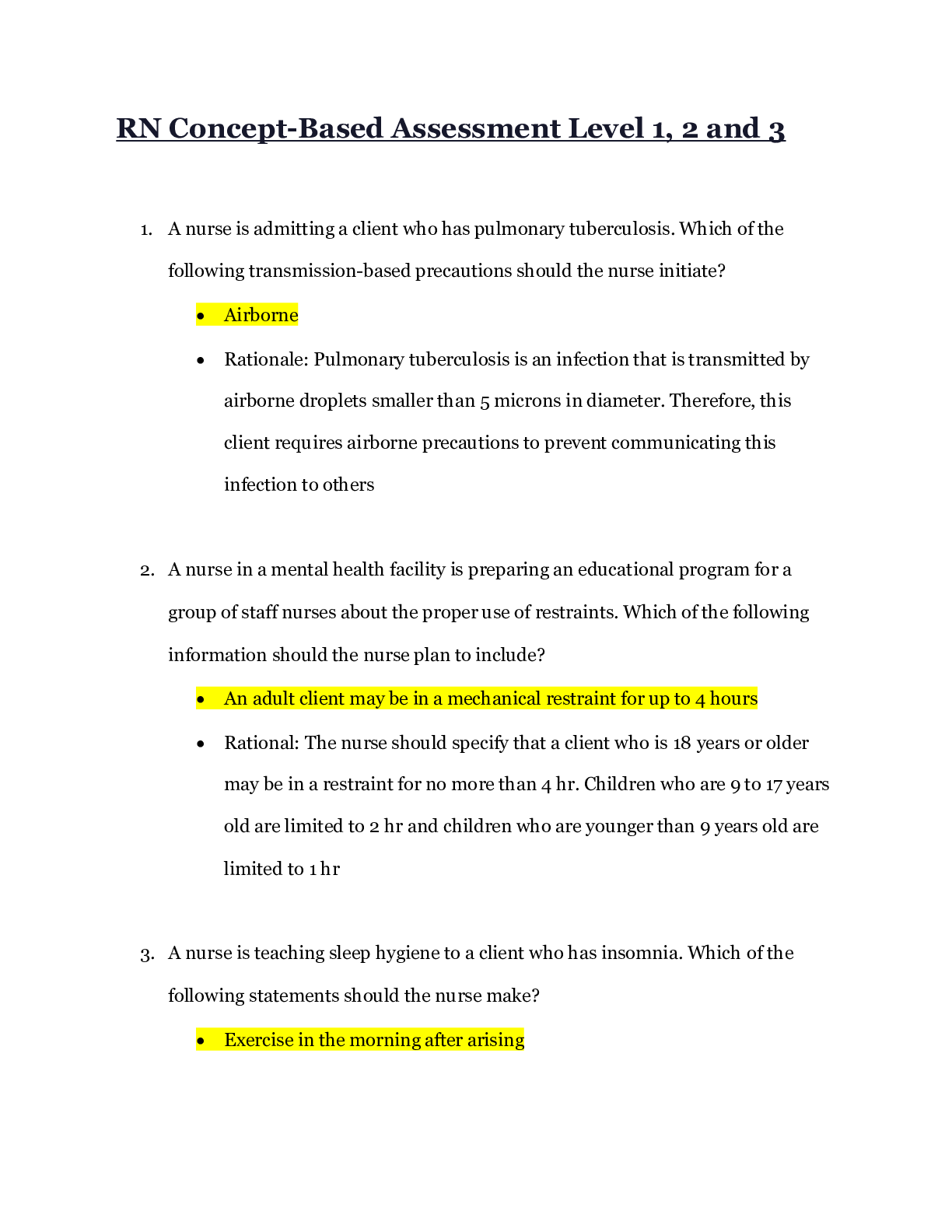
Reviews( 0 )
Document information
Connected school, study & course
About the document
Uploaded On
Jan 16, 2022
Number of pages
41
Written in
Additional information
This document has been written for:
Uploaded
Jan 16, 2022
Downloads
0
Views
94

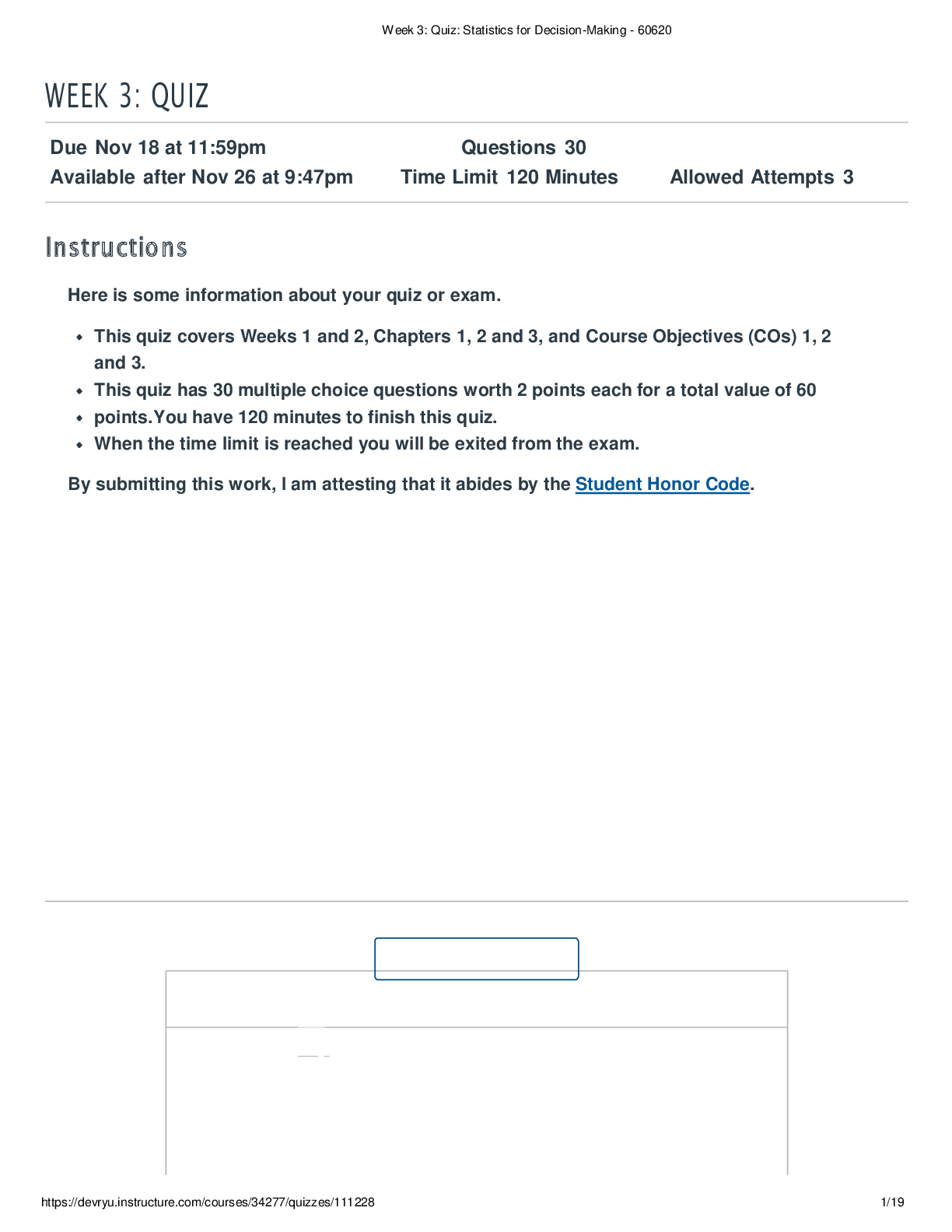

.png)










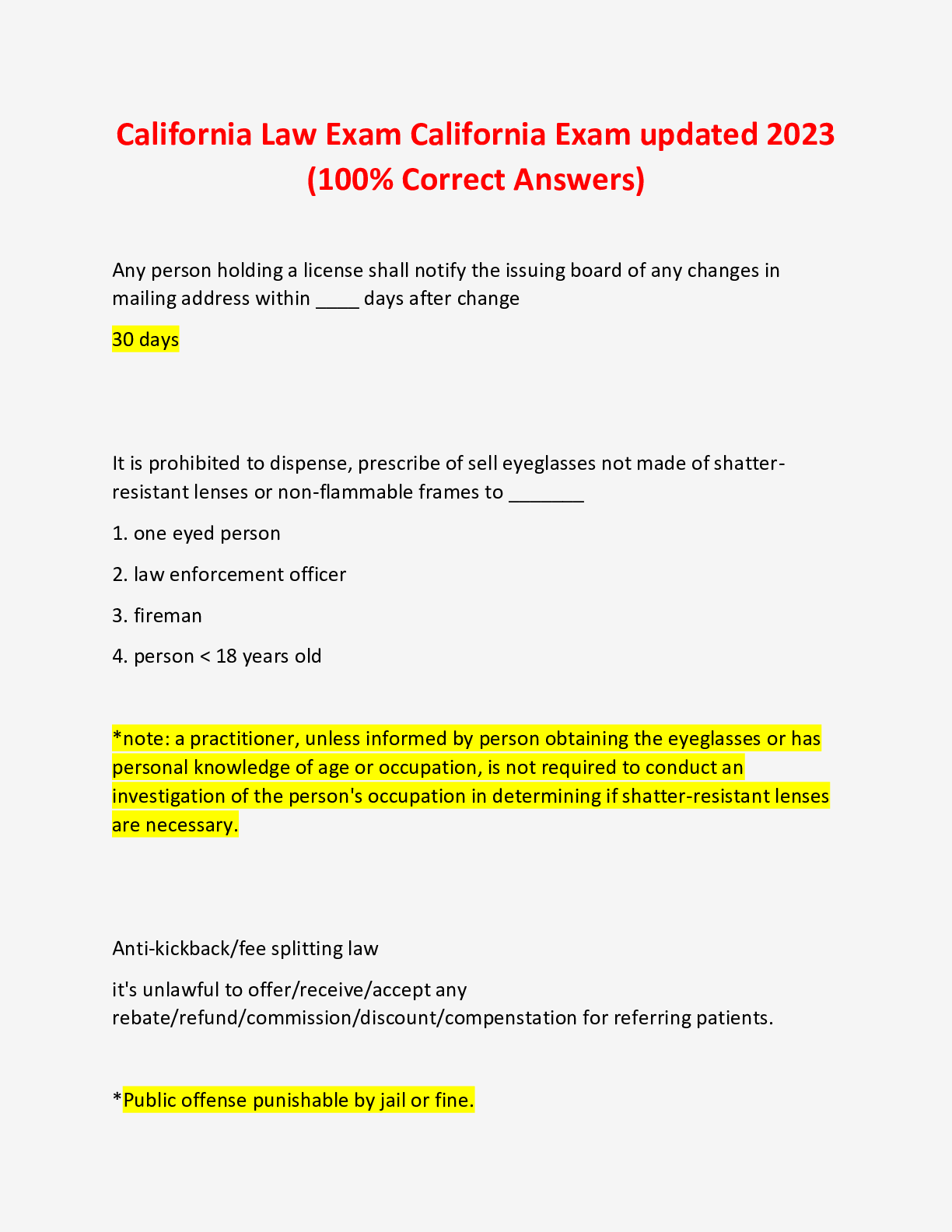


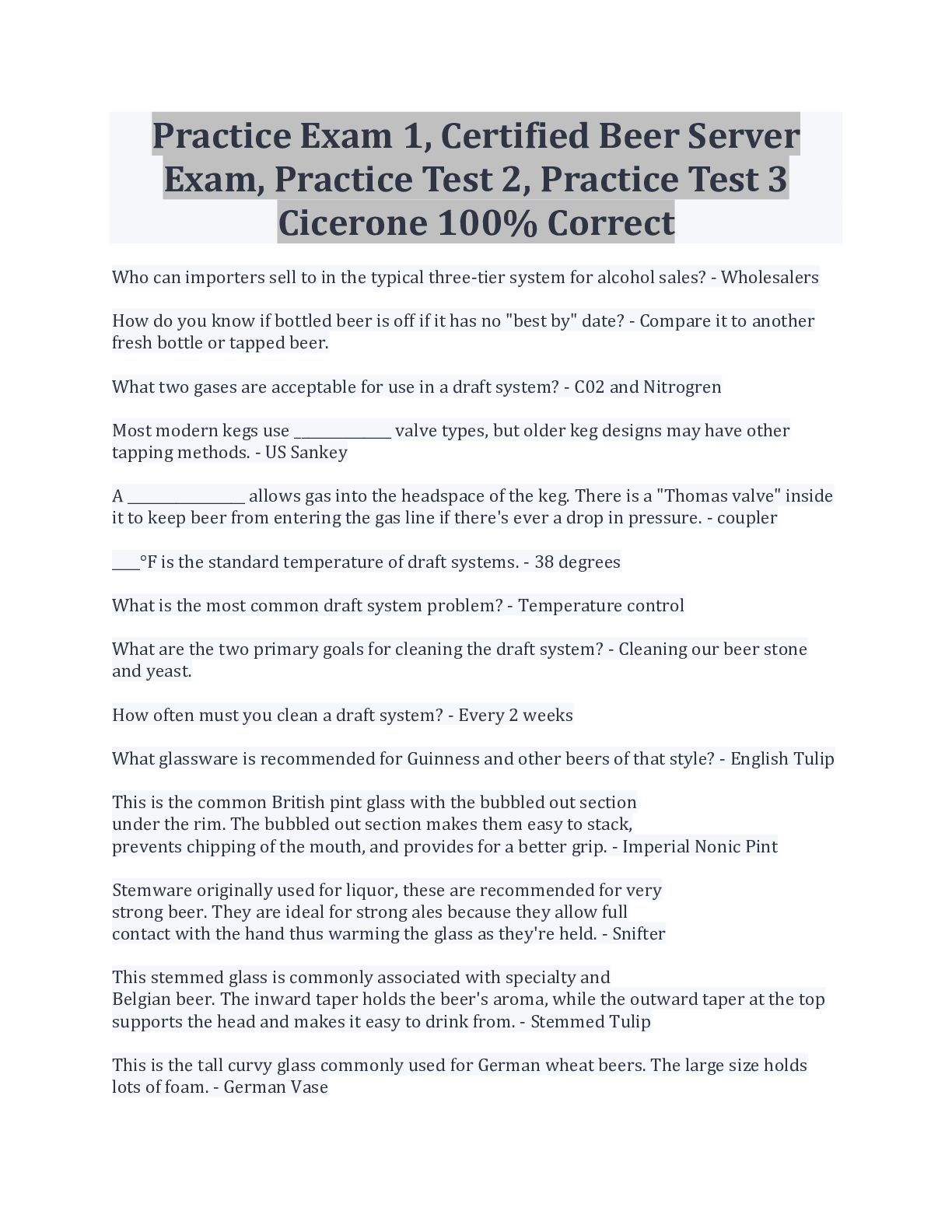
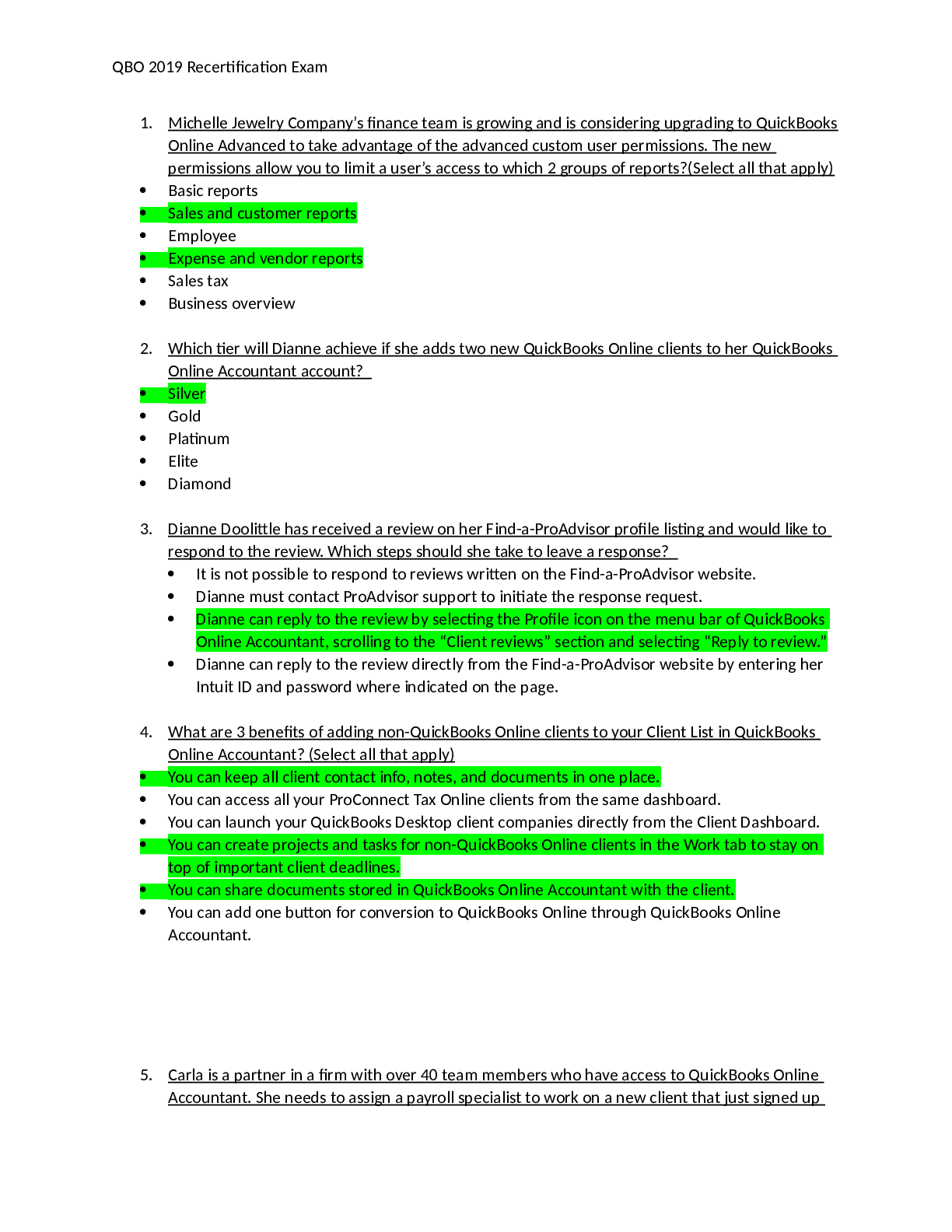
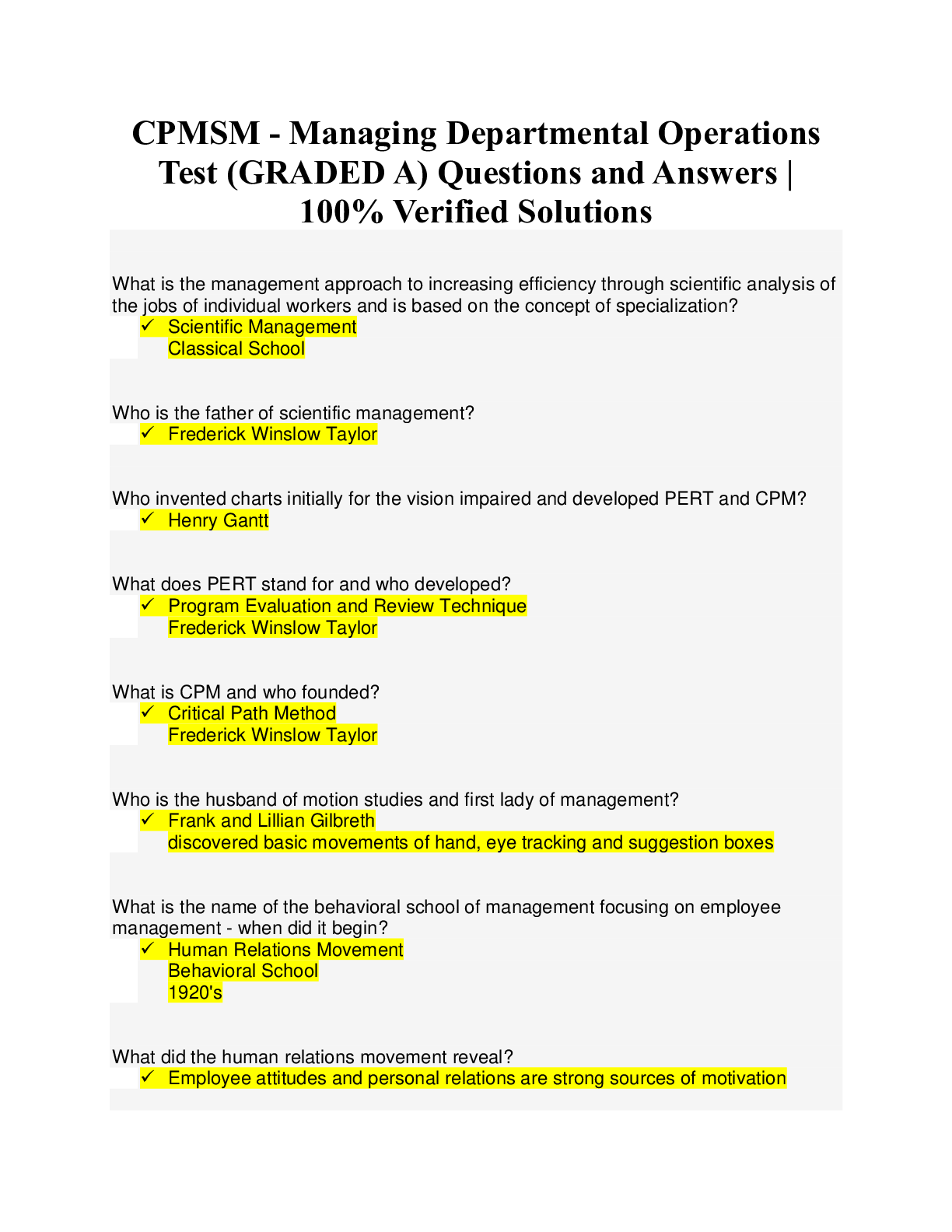
 (1).png)
